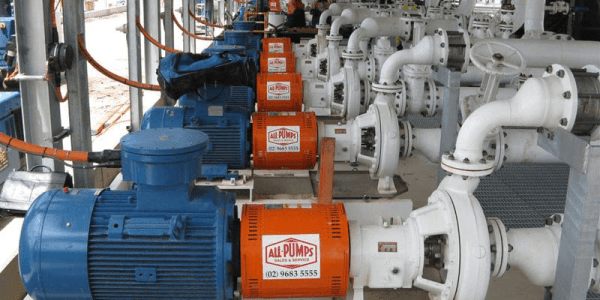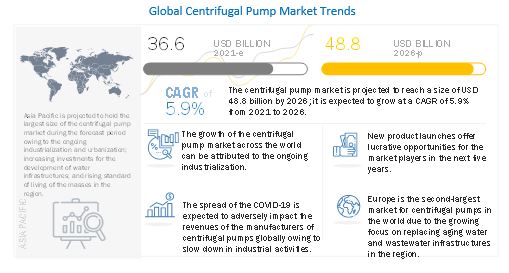
According to the new market research report, “The global centrifugal pump market size is projected to reach USD 48.8 billion by 2026 from an estimated value of USD 36.6 billion in 2021, at a CAGR of 5.9%.“
The key drivers for the centrifugal pump market include intensified demand for water and wastewater management in developed countries; surged investments in global construction industry; high demand for centrifugal pumps from agricultural sector.
View Full Report Summary: https://www.marketsandmarkets.com/Market-Reports/centrifugal-pump-market-17494785.html

COVID-19 Impact on the global centrifugal pump market
The outbreak of the COVID-19 pandemic has slowed the growth of the centrifugal pump market. This slowdown is mainly due to economic contractions, resulted from a halt in investments from various end-use industries. For instance, in the mining industry, the ongoing impact of the COVID-19 pandemic remains uncertain; with every passing day, the crisis is adversely affecting the supply chains and demand for commodities. Significant price drops were observed across major commodities, while in some cases, prices remain to be passive.
Key Market Players:
The circuit breaker market is dominated by major players that are established brand names with an extensive regional presence, along with many local and regional players in emerging economies. The key players in the centrifugal pump market include companies such as Xylem (US), Sulzer (Switzerland), KSB (Germany), Wilo (Germany), Grundfos (Denmark), and Flowserve (US).
Download PDF Brochure:https://www.marketsandmarkets.com/pdfdownloadNew.asp?id=17494785
The industrial segment is estimated to be the fastest-growing segment of the centrifugal pump market, by end-user, from 2021 to 2026. This segment is driven by factors such as the increasing demand for freshwater in developing regions such as Asia Pacific and Africa. A focus on reducing carbon emissions is leading to the increased demand for cleaner sources of power generation which, in turn, would result in a rising demand for centrifugal pumps used as boiler feed pumps, condensate extraction, and cooling water pumps in the power generation industry.
Global Centrifugal Pump Market, by type
Based on type, the overhung impeller centrifugal pump segment is expected to grow at the fastest rate from 2021 to 2026. This is due to various factors such as low installation cost as compared to between bearing centrifugal pumps. Overhung impeller pumps are installed with the lowest cost materials such as iron casings with brass or bronze impellers. They take up less floor space with slurry options such as rubber linings and offer reasonable efficiency. They are used in residential, commercial, and chemical applications. This segment is expected to have a higher market share due to the widespread implementation and easy operation of overhung impeller centrifugal pumps. The growing renewable energy sector also supports the growth of the overhung impeller pump segment with many solar power projects deploying these pumps for power generation.
Speak to Analyst: https://www.marketsandmarkets.com/speaktoanalystNew.asp?id=17494785
Global Centrifugal Pump Market, by stage
Based on stage, the single-stage segment is projected to grow at the highest CAGR from 2021 to 2026. The reliability and low maintenance costs of single-stage pumps in applications with moderate dynamic heads such as water pumping stations, which are some of the most common applications of submersible pumps, are expected to boost their demand for single-stage pumps across the globe.
Asia Pacific: Largest market size during the forecast period
The centrifugal pump market has been segmented, based on region, into Asia Pacific, Europe, North America, Middle East, South America, and Africa. Asia Pacific is projected to grow at the fastest rate, from 2019 to 2026, followed by the North America and Middle. Countries such as China and Japan are the largest markets in Asia Pacific and have increased their investments in the infrastructure and power sectors in the recent past. China accounted for the maximum share in the market in Asia Pacific in 2020 and is projected to grow at the highest CAGR of 6.5%, from 2021 to 2026. Increasing industrialization, investments in water and wastewater treatment infrastructure, growing urbanization, and rising demand for proper sanitation are the major factors impacting the growth of the centrifugal pump market in this region.
Request Sample Pages: https://www.marketsandmarkets.com/requestsampleNew.asp?id=17494785
Recent Developments:
- In November 2020, Sulzer was awarded a contract from Ringkøbing-Skjern Forsyning A/S (a Danish water utility) to provide pumps for a major flood defense project in Denmark. Two new pumping stations have been constructed to mitigate the impact of rising water levels during rain, drainage, and cloudburst water. Sulzer will supply one XFP baseload pump and three VUPX peak load pumps for the Ringkøbing pumping station, together with one XFP baseload pump and four VUPX peak load pumps for the adjacent Skælbækker station.
- In May 2020, Wilo expanded its presence with the establishment of a new headquarter and production facility in Cedarburg, Wisconsin, US. The new headquarters will bring the combined operations of Wilo USA, Weil Pump, Scot Pump, and Wilo Machine Co. to a single production site.
- In April 2020, Pleuger has expanded its presence in Singapore to strengthen its footprint in the Asian market.
- In July 2019, Xylem launched a new product, Flygt N3069 stainless steel centrifugal pump. It is specifically manufactured for industrial processes containing high chloride or extreme pH levels and helps in corrosion resistance.
- In January 2019, Atlas Copco introduced a wide range of high-quality electric centrifugal pumps designed specifically for drainage, sludge, and slurry pumping applications. The pumps help in preventing product failure, human errors, sudden loss of voltage, and overheating.


